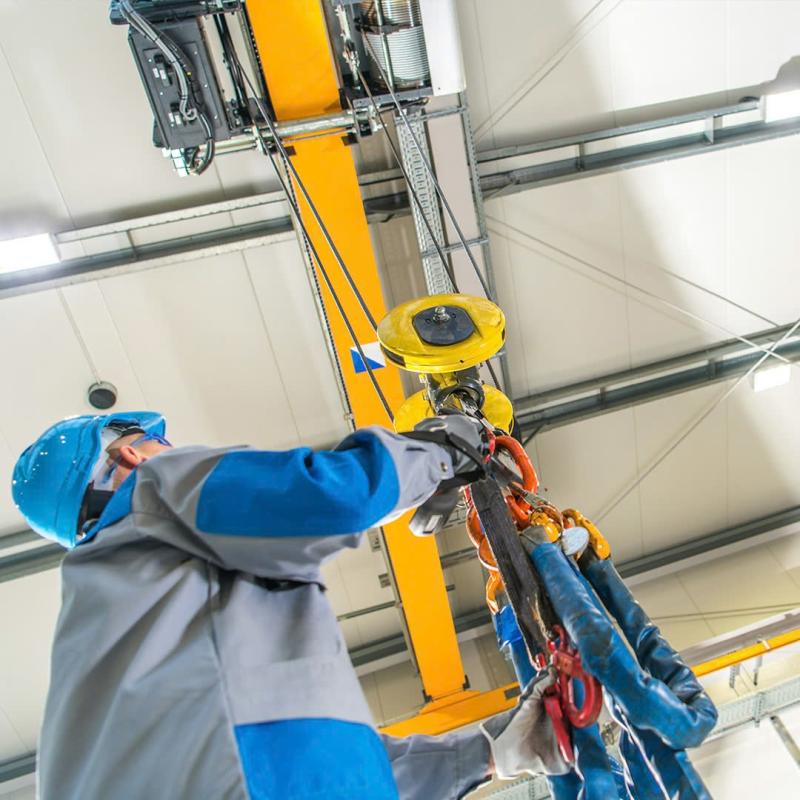



One of the most effective tools for boosting material handling productivity is the jib crane. Whether you're running a warehouse, fabrication facility, or manufacturing line, jib cranes offer flexibility, safety, and space-saving advantages that outperform many traditional lifting systems.
This comprehensive guide explores how different types of jib cranes, including freestanding jib cranes, wall mounted jib cranes, ceiling mounted jib cranes, articulating jib cranes, and pillar jib cranes, can help improve workflow, reduce labor costs, and minimize downtime.
A jib crane is a type of crane featuring a horizontal arm (jib or boom) that supports a lifting mechanism. This arm can rotate to various degrees, allowing for flexible lifting and material movement in a specific radius.
Industries are increasingly adopting jib cranes to streamline material transport within confined spaces. Unlike overhead cranes or gantries, they require less infrastructure modification and can be customized based on application needs.
If you're new to these systems, explore the full Jib Cranes Trends In The Future to understand the growing shift toward compact, versatile lifting equipment.
These are standalone units that do not rely on building structures for support. Freestanding jib cranes are ideal for outdoor use or open warehouse spaces where full 360-degree rotation is required. They provide:
High load capacity
Complete rotational freedom
Customizable height and boom length
As the name suggests, these cranes are attached directly to structural walls or columns. Aardwolf’s Wall-mounted Jib Cranes Solutions are perfect for:
Saving floor space
Providing up to 180° rotation
Supporting workstations alongside walls
These cranes are particularly useful in fabrication shops or automotive workshops where space is limited but frequent lifting is required.
Installed on building ceilings or trusses, ceiling mounted jib cranes are designed for maximizing workspace without sacrificing floor or wall space. These are common in assembly lines and cleanroom environments where ground-level clearance is essential.
These cranes come with a two-arm design allowing for flexible, segmented movement. Aardwolf offers models like the Articulated Jib Cranes Wall-mounted, which are especially effective when lifting around obstacles or machinery.
Advantages:
Dual pivot points for complex lifting paths
Ideal for congested workstations
Enhanced reachability
How do jib cranes stack up against traditional hoists, davit arms, and overhead cranes?
According to Jib Crane Comparison, jib cranes:
Offer better localized lifting control
Are easier and cheaper to install
Provide safer manual handling in tight spaces
They may not be suitable for long-span transport (like an overhead crane) but excel in consistent spot lifting at workstations.
A ceiling-mounted jib crane was installed over a conveyor-fed assembly line. This crane allowed operators to lift engine parts from bins and swing them precisely into position, reducing cycle time by 20%.
A freestanding jib crane with vacuum lifter integration was deployed to rotate and transfer granite slabs. Workers could now load polishing machines single-handedly, improving safety and throughput.
For more insight on applications, check out Aardwolf's article on Industrial Jib Cranes In The Future.
Faster Cycle Times
Operators can handle more loads per hour with precision and less fatigue.
Reduced Injury Risks
Minimized manual handling significantly lowers strain and accident rates.
Better Use of Floor Space
Options like wall and ceiling mounting free up room for other operations.
Cost-Effective Installation
Compared to gantries or overhead cranes, jib systems can be installed with less engineering.
Choosing the right system depends on your operational layout. The Aardwolf guide on Applying a Jib Crane in Your Manufacturing walks you through:
Assessing floor vs. wall vs. ceiling mounting options
Calculating boom length, height, and capacity
Installing with safety and compliance in mind
When considering installation, always evaluate:
Space availability: Freestanding vs. wall-mounted
Load type and frequency: Light-duty vs. heavy-duty usage
Rotation requirement: 180° for wall, 360° for freestanding
Explore more configurations via Exploring Articulated Jib Cranes Wall-mounted.
The role of jib cranes continues to evolve. With increasing automation and modular manufacturing demands, companies are shifting toward ergonomic and adaptable lifting systems.
As noted in the Jib Cranes Trends In The Future, advanced features like electric hoists, wireless remote controls, and integrated sensors are becoming standard.
From pillar jib cranes in mold-changing areas to articulating wall-mounted cranes in automotive lines, choosing the right jib crane model can revolutionize how your team handles materials.
By understanding your workspace needs and comparing installation options, you can select the most efficient system to boost productivity and safety.
Explore your next solution with Wall-mounted Jib Cranes Solutions from Aardwolf and take the first step toward a safer, faster workflow.
References
1. How to operate a Jib Cranes safely
3. Over brace jib crane wall mounted
5. Is a Jib Crane a Gantry Crane
6. Articulated Jib Crane Wall Mounted
8. Manual Counterbalance Crane
10. Over Braced Jib Crane Column Mounted
Sign up to receive the latest info on new Aardwolf products, special offers and more.
By signing up you agree to receive emails from Aardwolf with news, special offers, promotions and other information. You can unsubscribe at any time.